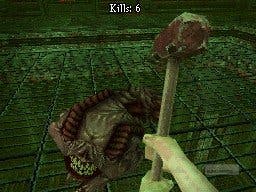Dementium II
Insane in the membrane.
Furthermore, Dementium II's new inventory system comes with a generous layout of ten slots. This is a welcome change as you can hoard health packs and adrenaline shots for trickier boss battles, as well as stockpiling ammo for your favoured armament. But as the monsters no longer respawn ad-infinitum, this time around poor ammo conservation isn't so punishing. Thank god for that
This is a better designed and more structured experience, with less of a sense of déjà vu as you travel between areas. Indeed, while the previous game relied on bland rooms and identikit corridors, William's second quest for sanity sees him travelling from the prison infirmary to more varied location, including a frozen lake and a graveyard filled with tombstones naming the game's developers. It seems Renegade Kid isn't so worried about tempting fate.
An improved map also means you're less likely to get lost as it automatically highlights every area you've visited. Even the irksome puzzles have been ditched for more logical brain-teasers, ranging from arranging jars of eyeballs into ascending order, to sorting bits of wire - Pipe Mania style - to complete a circuit. As necessary as these many revisions were, number one on the list was a proper manual save system, and thanks to Dementium II's liberal sprinkling of save points in the form of red mirrors, this sequel is an altogether less stressful experience.

Having said that, I was amazed at how quickly I went from the opening cinematic to the end credits, as I was able to rinse Dementium II in just under five hours. In terms of extra content, there's a single side-quest element where you can backtrack to pick up a secret weapon. And that's only a ten-minute detour.
It's also telling that we've gone from 16 chapters in the first game to just five in the second. Admittedly these five chapters are considerably longer and offer a far tighter gameplay experience, but at the same time Dementium II is over before it's even started - and it's unlikely you'll find much replay value in the no-thrills Survival Mode. The narrative is also surprisingly thin for a survival horror, with bits of the plot being conveyed through mental monologues with the Doctor, as well as stumbled upon through postcards and newspaper clippings.
At least the five bosses feel more threatening and less recycled. The best require the player to think beyond simply emptying both barrels as quickly as possible. But with a steady stylus finger and effective rationing of both ammo and health items, it's no real feat to complete Dementium II on the normal difficulty without dying once. It's also worth saying that the ending is an even bigger let-down than the first, which if you've played Dementium, is really saying something.

All things considered then it's hard to rate Dementium II too highly, because although it's visually impressive for a DS game, it doesn't do enough to feel particularly inspired or original. At the same time, Renegade Kid has designed a sequel which keeps the tight combat of the original, while improving the Dementium formula in most key areas.
To put it bluntly, Dementium II represents one of the better survival horror experiences on a system not known for its support of the genre. But rather than supplying moments of DS-dropping terror - or even the slightest glimpse thereof - its trump card is its solid design and engaging combat. And if you pay the full price, you might come away feeling short changed.

